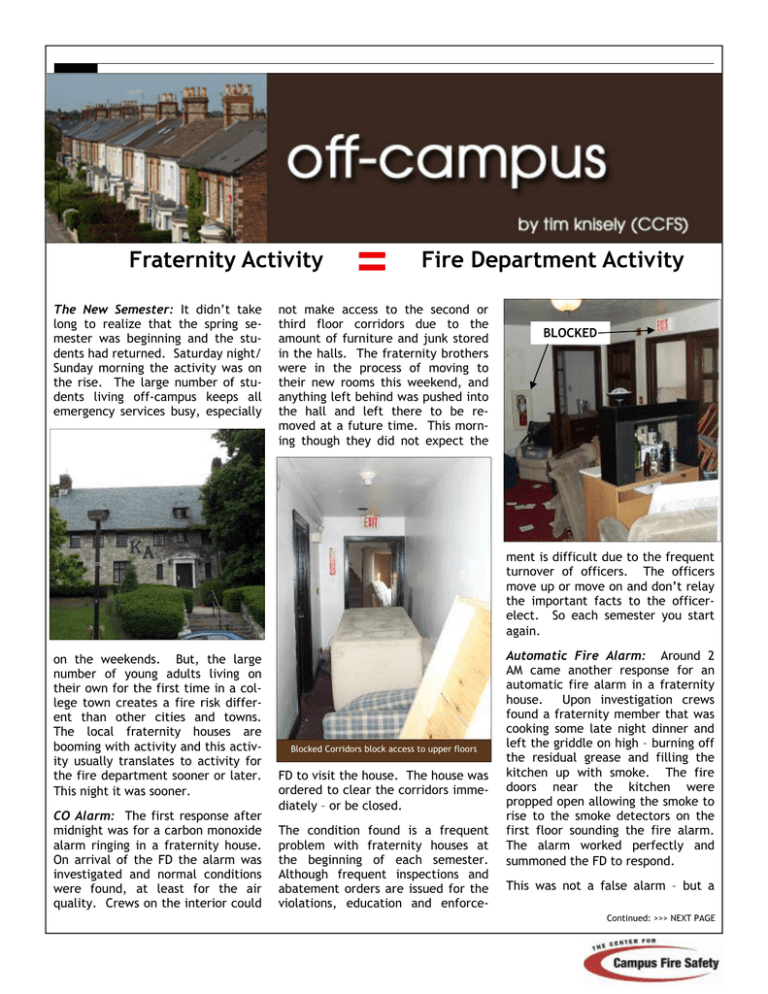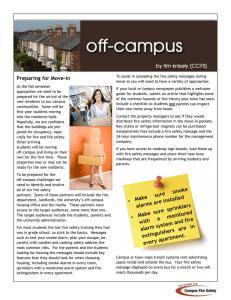= Fraternity Activity Fire Department Activity
advertisement

Fraternity Activity The New Semester: It didn’t take long to realize that the spring semester was beginning and the students had returned. Saturday night/ Sunday morning the activity was on the rise. The large number of students living off-campus keeps all emergency services busy, especially = Fire Department Activity not make access to the second or third floor corridors due to the amount of furniture and junk stored in the halls. The fraternity brothers were in the process of moving to their new rooms this weekend, and anything left behind was pushed into the hall and left there to be removed at a future time. This morning though they did not expect the BLOCKED ment is difficult due to the frequent turnover of officers. The officers move up or move on and don’t relay the important facts to the officerelect. So each semester you start again. on the weekends. But, the large number of young adults living on their own for the first time in a college town creates a fire risk different than other cities and towns. The local fraternity houses are booming with activity and this activity usually translates to activity for the fire department sooner or later. This night it was sooner. CO Alarm: The first response after midnight was for a carbon monoxide alarm ringing in a fraternity house. On arrival of the FD the alarm was investigated and normal conditions were found, at least for the air quality. Crews on the interior could Blocked Corridors block access to upper floors FD to visit the house. The house was ordered to clear the corridors immediately – or be closed. The condition found is a frequent problem with fraternity houses at the beginning of each semester. Although frequent inspections and abatement orders are issued for the violations, education and enforce- Automatic Fire Alarm: Around 2 AM came another response for an automatic fire alarm in a fraternity house. Upon investigation crews found a fraternity member that was cooking some late night dinner and left the griddle on high – burning off the residual grease and filling the kitchen up with smoke. The fire doors near the kitchen were propped open allowing the smoke to rise to the smoke detectors on the first floor sounding the fire alarm. The alarm worked perfectly and summoned the FD to respond. This was not a false alarm – but a Continued: >>> NEXT PAGE CONTINUED: OFF-CAMPUS HOUSING response that could have been prevented if the “chef” was aware of the hazards from the griddle and if the fire doors were kept closed to prevent the spread of smoke. This response created another chance to educate the members about the importance of safe cooking and fire safe practices Building Fire: At 3:45 was the third call of the night in a fraternity house – this time for a fire in a bedroom. Occupants in the house heard a single station smoke alarm sounding in a bedroom, opened the door and found a futon on fire. They called 9-1-1 and began evacuating the other occupants. The engine company arrived with fire evident inside the bedroom. Upon entry into the bedroom a small fire was found and quickly extinguished. They also found the bedroom occupant who was either unable to recognize the danger he was in or unable to self rescue himself. He was removed from the house by the FD and treated by EMS for smoke inhalation. His first recollection of the night was when he awoke in the back of an ambulance. The fire was caused by the careless disposal of smoking materials and the damage was contained to the bedroom. The fire never got large enough or hot enough to activate the sprinkler in the room. While the fire was minor several issues were identified during this incident that could have made the outcome worse. The occupants heard an alarm and investigated, discovered the fire and called 9-1-1. However, no one pulled the fire alarm, or noticed the room occupant still inside the room. A fire extinguisher outside the fire room was discharged previously and placed back in the bracket not available for use. The corridors were also obstructed with furniture and junk making egress more difficult and fire department access even more challenging. The fire alarm did activate automatically after the FD made entry and the smoke reached the hallway smoke detector. The fire displaced the occupant of the bedroom, but the fire code violations existing prior to the fire forced the house to close until the violations were corrected. This house has a history of serious code violations and also had two previous fires that were contained by the sprinkler system. The building owners had previously installed a sprinkler system, fire alarm system, single station smoke alarms and fire extinguishers. There isn’t much more that can be done to make this building safer, except for taking action against those creating the violations and educating the residents. Education and Enforcement: These fire incidents prove that detection and suppression systems work and are critical in all types of student housing, especially the fraternity house. Regardless of the types of protection provided fire safety education is vital for all occupants. Proper response to all types of alarms, how and when to activate the fire alarm and immediately evacuating when an alarm sounds. More important is trying to prevent the creation of hazards that makes off-campus housing more dangerous. Blocked hallways and stairways are not just a problem in a fraternity house, but can be found in nearly any type of housing. Recognizing these risks and taking appropriate action to remove the risk is the purpose of education. The fire department or AHJ can only reach a percentage of students living in their community. CONTINUED: OFF-CAMPUS HOUSING Landlords and property managers need to take a proactive role in monitoring the conditions of offcampus housing and educating their tenants. Weekly or monthly checks of the properties can identify many of these hazards as well as correct them. Checking the smoke alarms and fire extinguishers every time maintenance visits a property will provide another level of vigilance to make sure the occupants are safe. A Never Ending Process: It isn’t hard to identify new ideas for educational outreach after seeing these properties first hand – especially at 3 AM. The hard part is gaining access to the students. By identifying partners and sharing information we can make the properties safer and educate the occupants at the same time. Keep in mind that the next semester will bring a new group of residents living on their own for the first time, so the process needs to start again. ______________________ Tim Knisely is the Senior Fire Inspector for the Centre Region Code Administration in State College, PA. He is also on the Board of Directors and Treasurer for the Center for Campus Fire Safety. Some private companies offer a service where safety checks are provided in off-campus housing on a daily, weekly or monthly basis. While this service can be expensive, it provides peace of mind for the landlord and the parents that the properties are being maintained. University offices such as Student Affairs or Greek Life need to be involved in the education and enforcement efforts. Each town and gown will have a variety of partners or tools to aid in this effort. The police department is a frequent visitor to properties that can be extra eyes and ears for the AHJ or the owner. Providing basic code awareness to the police department as well as a method for them to refer violations allows unsafe conditions that are observed to be quickly corrected. The AHJ can provide education, enforcement or both to make corrections with the responsible party. Jan 30—State House News FIRE EXPERTS: EQUIP DORMS WITH FIRE-RESISTANT PAINT: Although traditional dormitory rooms would burn to rubble within minutes if a fire were to break out, fire-resistant paint could save college students’ lives and slow the spread of flames, fire experts told a legislative committee today. Officials from universities across the state urged the Committee on Public Safety to support a bill (S 1412) which would require all student housing, nursing homes and assisted living facilities to coat their walls with “intumescent, refractory paint.” “[Students] often engage in very risk behavior,” said Peter Rizzi, Northeastern University’s fire safety officer. “This technology will give us the potential to respond to any emergency.” In testimony, fire officials cited statistics indicating fires in campus residences have spiked since 1980, as many as a third of all fires a result of arson. In addition, many students remain indoors, refusing to heed fire alarms, a phenomenon called “alarm apathy.” “Someday, hopefully sooner rather than later, this will be what we do with dormitories,” said Sen. Stephen Brewer (D-Barre), a member of the committee. The committee did not discuss the cost of the product, but some companies list fire-resistant paint between $70 and $90 per gallon. The bill is sponsored by Sen. Steven Panagiotakos (D-Lowell), chairman of the Senate Ways and Means Committee.



